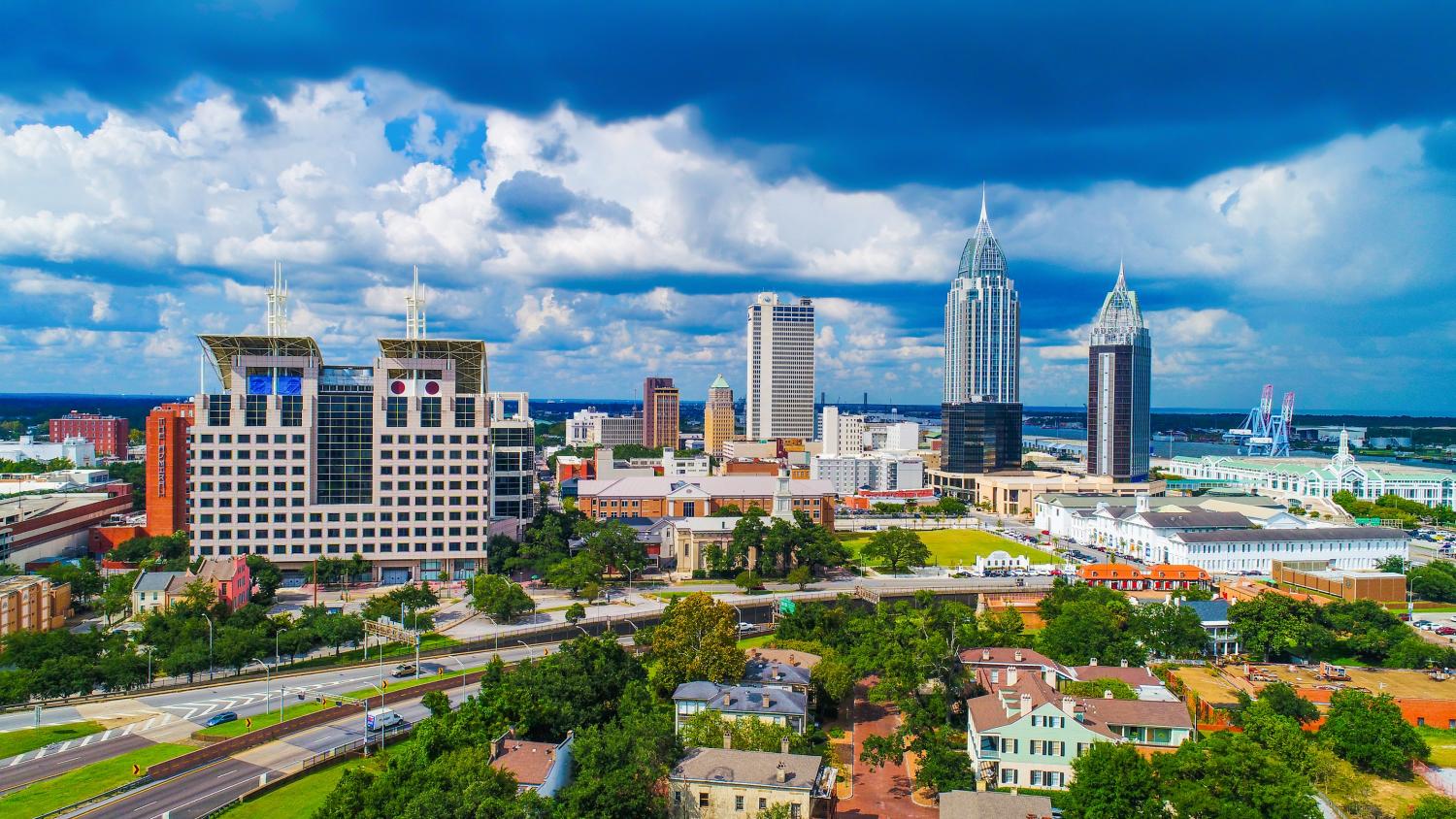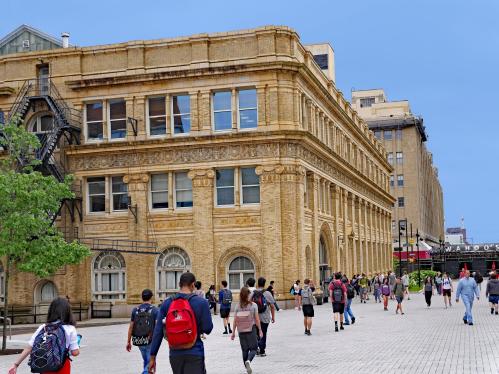Contents
- Manufacturing is an economic engine in Mobile
- Postsecondary education provides a wage boost for Mobile’s workers
- Mobile’s manufacturing sector is marked by troubling racial disparities
- Higher education collaborations in Mobile provide a benchmark for further investment
Imagine the following career trajectory. An elementary school student goes on a field trip to a science center where she flies a plane and walks in space—virtually of course. Several years later, as a high school student, she enrolls in an apprenticeship program with an aviation manufacturing company that will lead to a well-paying job after graduation. She is then presented with opportunities to grow her skills either through acquiring additional industry-recognized certifications or through pathways to college degrees.
States and cities across the nation dream of achieving outcomes like this for their residents. In Mobile, Ala., this vision is quickly becoming a reality thanks to innovative collaborations among key institutions and leaders.
Last summer, Mobile opened Flight Works Alabama—a 15,000-square-foot science center where visitors can fly virtual jets, walk in space, attend workshops, and earn certifications. Flight Works Alabama is a joint venture between state lawmakers and educators working with Airbus, a leading aerospace manufacturing company that has a major facility in Mobile. At the beginning of this year, the first graduates of Flight Works Alabama’s FlightPath9 apprenticeship program began their careers at Airbus. FlightPath9 is a workforce training program for high school seniors that combines hands-on technical instruction with soft-skills development, preparing students for Airbus’ onboarding program. Flight Works Alabama Director Michelle Hurdle explains that the vision for FlightPath9 is to provide “an avenue for students to master an array of skills while delivering an educational program to our community with clear and measurable results.”
These efforts reflect a growing momentum in Mobile’s efforts to create talent pipelines for its residents. In a 2018 profile of Mobile, the Lumina Foundation spotlighted a comparable internship program for high school juniors and seniors offered through Outokumpu, a stainless steel manufacturing firm with a 1,500 employee plant in Calvert, Ala., an unincorporated community in Mobile. This internship opportunity is also connected to cooperative programs offered through two community colleges in Mobile: Coastal Alabama and Bishop State (which is one of the nation’s few two-year HBCU institutions). In recognition of Mobile’s innovations, the Lumina Foundation designated the city a Talent Hub in 2018 and awarded the Mobile Area Education Foundation with a sizable grant to support the Foundation’s goal of boosting postsecondary education attainment rates.
Providing vocational training and onramps to careers are obviously good and necessary. However, job conditions, including good pay, will determine if people will stay in those fields long enough to develop. Our research finds that there are troubling racial disparities in wages within this sector of Mobile’s labor market, which mitigate the impacts of innovative workforce development strategies. In fact, as we will demonstrate, the racial earnings gap is larger than the gap between workers with degrees and those without degrees. We thus argue that efforts to build pathways into well-paying manufacturing jobs need to be explicitly designed for racial equity.
Manufacturing is an economic engine in Mobile
Manufacturing is the main economic driver for the Mobile metropolitan area as well as for Alabama. The Mobile Chamber of Commerce proudly highlights that the area’s “economic development success coincides with the region’s robust manufacturing influence in aviation and aerospace; chemical; information technology; maritime; warehouse and distribution; and steel.” The state of Alabama has several key manufacturing industries embedded together that benefit from interconnected infrastructure and economies of scale and scope.
As detailed by the Alabama Chamber of Commerce, these industries include everything from aviation to bioscience to steel. According to the National Association of Manufacturers, Alabama’s manufacturing industries account for just over 17% of the state’s total output (upwards of $37 billion in 2018). These industries employ 13% of the state’s workforce (an average of 271,000 workers) with average annual compensation of $68,000.
According to our analysis of the American Community Survey, manufacturing is the 2nd largest industry in the Mobile metro, employing 13% of prime age workers as depicted in Figure 1 below.

Manufacturing is also the third highest paying industry in the metro area, with a median wage of $54,334:

As advancements in research and development continue to reshape manufacturing industries, Mobile’s investment in productive capacity will continue to pay dividends while offering good jobs to its residents. As detailed in the next section, however, an increasing number of those jobs will require either postsecondary education, trade school, or an apprenticeship program.
Postsecondary education provides a wage boost for Mobile’s workers
In the 20th century, manufacturing jobs required little formal education. Today, manufacturing work is becoming increasingly specialized and requires continued training. A 2019 report by Georgetown University’s Center on Education and the Workforce details that the overall national labor market for manufacturing is experiencing structural shifts toward jobs that require postsecondary education; jobs which also tend to be higher paying and less physically demanding than those available to high school graduates.
The Georgetown report demonstrates that education level leads to division in labor within subfields of manufacturing: “workers on the high school pathway are more concentrated in animal slaughtering and processing and in metals manufacturing. Middle-skills workers and workers with bachelor’s degrees are clustered in electronic component, aircraft, medical equipment, and industrial chemical manufacturing. The pharmaceutical industry and instruments manufacturing in particular employ large numbers of workers with bachelor’s degrees.”
As noted above, much of Mobile’s manufacturing is clustered around aircraft and industrial. Applying the insights from the Georgetown report highlights the particular importance of the “middle-skill” category when fitting workers to the needs of the local industries in Mobile. The internship and apprenticeship models described above provide one way of helping workers gain the skills they need. And our data reveals that college and trade school credentials are an important part of the story.
Our analysis, depicted below, reveals a wage premium of $16,535 for workers possessing a college or trade school degree versus workers without that credential.

Considering this wage disparity, it is vital to note that middle-skills is the floor—not the ceiling—in educating future manufacturing workers. This also corresponds with the Georgetown report which finds at the national level that there are continuous declines in job opportunities for those lacking postsecondary education, even as there has been steady growth for those with a bachelor’s degree. The report also details that those with only an associate degree have experienced modest growth, but that the numbers for middle skill workers is negatively offset by those workers in the “some college, no degree” category who do not experience boosted wages without the needed credential. Taken together, this suggests that in addition to expanding opportunities for internships for high school students and apprenticeships for high school graduates, Mobile should also focus efforts on boosting college attainment, including two- and four-year degrees, as well as trade school certificates, apprenticeships, and other training initiatives.
Mobile’s manufacturing sector is marked by troubling racial disparities
While Mobile’s manufacturing sector offers a premium wage to its workers, it does not pay its workers equally. Our analysis reveals that there are stark racial disparities in wages, with Black workers making substantially less than non-Black workers.
The median earnings for Black workers in the manufacturing industry are a staggering $25,629 less than the median for non-Black workers (see Figure 5). And education does not make up for the racial income gap. As shown below, the racial gap in this industry is so dramatic that the median Black worker with a college or trade school degree in the manufacturing industry makes $875 less than the median white worker with no degree.

This analysis shows that simply increasing the number of workers with degrees in manufacturing, while important for boosted wages, cannot eliminate the racial earnings gap. Indeed, this data demonstrates that Black workers are forced to get a college or trade school degree just to achieve equity with non-Black workers without a degree. And when you combine this with the realization that Black students are likely taking on debt to finance these degrees, it becomes evident that it will take more than an increase in degrees to uproot the racism that is stealing wages from Black workers.
Of course, the manufacturing sector is not unique in its racial disparities. As the graph below shows, parity is the exception and not the rule in industries across Mobile’s labor market. There are some industries where the median Black worker makes significantly more: the Mining, Quarrying, and Oil and Gas Extraction and Military industries. But these industries collectively make up less than 1% of the metro area’s prime age workers. In other industries the median Black worker lags behind.

Given how central the manufacturing industry is to the local economy, both in terms of the percentage of workers it employs and the higher wages it provides, we believe it is essential for state and local policymakers to identify the root causes of that disparity and to develop initiatives that explicitly focus on building racial equity.
Higher education collaborations in Mobile provide a benchmark for further investment
As mentioned earlier, Mobile’s Bishop State Community College is one of the few two-year HBCU’s in the nation. In addition to cooperative ventures such as the internship program with Outokumpu (the stainless-steel manufacturing firm), Bishop State (along with fellow two-year college Coastal Alabama) has also partnered with the University of South Alabama (a local public university) to help students transfer into four-year programs.
An article in The Hechinger Report details how these college partnerships emerged out of a crisis, when Mobile policymakers used tax incentives to lure manufacturing firms to the area but then realized that many workers did not have the needed skills to fill those jobs. Amidst a groundswell of engagement from local leaders including the Chamber of Commerce and the Mobile Area Education Foundation, the metro area’s college presidents began actively collaborating as well. This collaboration includes the three intuitions of higher learning working together to increase college enrollment and degree attainment. In the words of Bishop State President Reginald Sykes, “We all understand that if we’re going to continue to recruit industries to come to Mobile, we all have to work together. K-12 can’t do it alone, the community colleges can’t do it alone, the university can’t do it alone.”
Bishop State is also leading the way in providing academic support for low-income and first-generation college students. And at the end of 2020, the U.S. Department of Education awarded Bishop State with a $1.3 million grant to help them expand their social support efforts for this school year. This grant can fund tutoring services as well as advising on filling out financial aid forms, transferring credits, and mapping out a degree.
These are important initiatives that we believe could be enhanced through Biden’s infrastructure plan which promises unprecedented levels of funding for the nation’s HBCUs, with a particular emphasis on expanding their capacity for R&D which could be pivotal for creating pipelines into more specialized manufacturing jobs. Bishop State is a natural destination for this new funding, given its recent expansions including the creation of a new Health Science building and an Advanced Manufacturing Center which will help students prepare for careers in industries like biotech and robotics.
Nevertheless, our research makes clear that college and trade school expansion alone will not fix the systemic racism encoded in Mobile’s manufacturing sector which is depressing wages for Black workers. Just as local Mobile leaders worked together to address the skilled labor shortage, they need to collaborate again to not only explicitly address racial equity in the manufacturing sector, but to address the local labor market more broadly.
The Brookings Institution is committed to quality, independence, and impact.
We are supported by a diverse array of funders. In line with our values and policies, each Brookings publication represents the sole views of its author(s).









